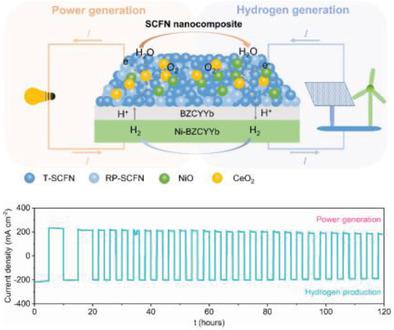当前位置:
X-MOL 学术
›
Adv. Energy Mater.
›
论文详情
Our official English website, www.x-mol.net, welcomes your
feedback! (Note: you will need to create a separate account there.)
Nanocomposites: A New Opportunity for Developing Highly Active and Durable Bifunctional Air Electrodes for Reversible Protonic Ceramic Cells
Advanced Energy Materials ( IF 24.4 ) Pub Date : 2021-08-04 , DOI: 10.1002/aenm.202101899 Yufei Song 1 , Jiapeng Liu 1 , Yuhao Wang 1 , Daqin Guan 2 , Arim Seong 3 , Mingzhuang Liang 2 , Matthew J. Robson 1 , Xiandong Xiong 2 , Zhiqi Zhang 1 , Guntae Kim 3 , Zongping Shao 2, 4 , Francesco Ciucci 1, 5
Advanced Energy Materials ( IF 24.4 ) Pub Date : 2021-08-04 , DOI: 10.1002/aenm.202101899 Yufei Song 1 , Jiapeng Liu 1 , Yuhao Wang 1 , Daqin Guan 2 , Arim Seong 3 , Mingzhuang Liang 2 , Matthew J. Robson 1 , Xiandong Xiong 2 , Zhiqi Zhang 1 , Guntae Kim 3 , Zongping Shao 2, 4 , Francesco Ciucci 1, 5
Affiliation

|
Reversible protonic ceramic cells (RePCCs) can facilitate the global transition to renewable energy sources by providing high efficiency, scalable, and fuel-flexible energy generation and storage at the grid level. However, RePCC technology is limited by the lack of durable air electrode materials with high activity toward the oxygen reduction/evolution reaction and water formation/water-splitting reaction. Herein, a novel nanocomposites concept for developing bifunctional RePCC electrodes with exceptional performance is reported. By harnessing the unique functionalities of nanoscale particles, nanocomposites can produce electrodes that simultaneously optimize reaction activity in both fuel cell/electrolysis operations. In this work, a nanocomposite electrode composed of tetragonal and Ruddlesden–Popper (RP) perovskite phases with a surface enriched by CeO2 and NiO nanoparticles is synthesized. Experiments and calculations identify that the RP phase promotes hydration and proton transfer, while NiO and CeO2 nanoparticles facilitate O2 surface exchange and O2- transfer from the surface to the major perovskite. This composite also ensures fast (H+/O2-/e-) triple-conduction, thereby promoting oxygen reduction/evolution reaction activities. The as-fabricated RePCC achieves an excellent peak power density of 531 mW cm-2 and an electrolysis current of −364 mA cm-2 at 1.3 V at 600 °C, while demonstrating exceptional reversible operation stability of 120 h at 550 °C.
中文翻译:

纳米复合材料:为可逆质子陶瓷电池开发高活性和耐用的双功能空气电极的新机遇
可逆质子陶瓷电池 (RePCCs) 可以通过在电网层面提供高效、可扩展和燃料灵活的能源生产和存储,促进全球向可再生能源的过渡。然而,RePCC 技术受到缺乏对氧还原/析出反应和水形成/水分解反应具有高活性的耐用空气电极材料的限制。本文报道了一种用于开发具有卓越性能的双功能 RePCC 电极的新型纳米复合材料概念。通过利用纳米级颗粒的独特功能,纳米复合材料可以生产同时优化燃料电池/电解操作中反应活性的电极。在这项工作中,2合成了 NiO 纳米颗粒。实验和计算表明,RP 相促进水合作用和质子转移,而 NiO 和 CeO 2纳米颗粒促进 O 2表面交换和 O 2-从表面转移到主要钙钛矿。这种复合材料还确保了快速 (H + /O 2- /e - ) 三重传导,从而促进了氧的还原/析出反应活动。制造的 RePCC在 600 °C 和 1.3 V 下实现了 531 mW cm -2的出色峰值功率密度和 -364 mA cm -2电解电流,同时在 550 °C 下表现出 120 小时的卓越可逆操作稳定性。
更新日期:2021-09-23
中文翻译:

纳米复合材料:为可逆质子陶瓷电池开发高活性和耐用的双功能空气电极的新机遇
可逆质子陶瓷电池 (RePCCs) 可以通过在电网层面提供高效、可扩展和燃料灵活的能源生产和存储,促进全球向可再生能源的过渡。然而,RePCC 技术受到缺乏对氧还原/析出反应和水形成/水分解反应具有高活性的耐用空气电极材料的限制。本文报道了一种用于开发具有卓越性能的双功能 RePCC 电极的新型纳米复合材料概念。通过利用纳米级颗粒的独特功能,纳米复合材料可以生产同时优化燃料电池/电解操作中反应活性的电极。在这项工作中,2合成了 NiO 纳米颗粒。实验和计算表明,RP 相促进水合作用和质子转移,而 NiO 和 CeO 2纳米颗粒促进 O 2表面交换和 O 2-从表面转移到主要钙钛矿。这种复合材料还确保了快速 (H + /O 2- /e - ) 三重传导,从而促进了氧的还原/析出反应活动。制造的 RePCC在 600 °C 和 1.3 V 下实现了 531 mW cm -2的出色峰值功率密度和 -364 mA cm -2电解电流,同时在 550 °C 下表现出 120 小时的卓越可逆操作稳定性。











































 京公网安备 11010802027423号
京公网安备 11010802027423号